


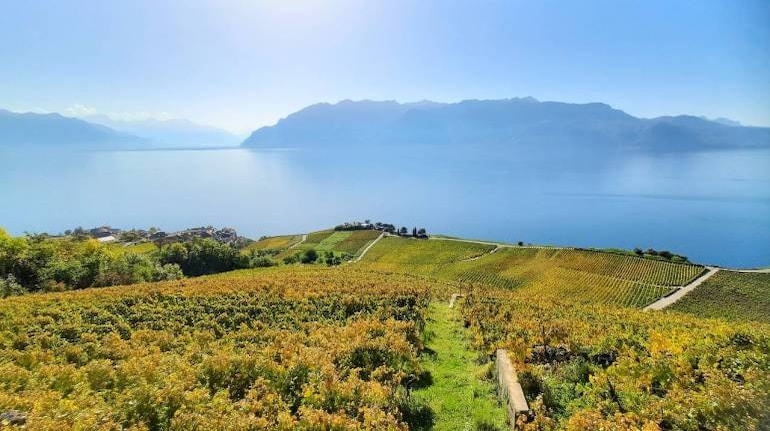
Towards the eastern end of the oblong Lake Geneva in Switzerland, the sloping banks of the lake are a surreal sight. Beautifully arranged rows of vines cascade down to the banks. At the height of the fruiting season, the age-old stems are weighed down by bunches of grapes, waiting for their transformation into a variety of delicious wines. But most other times of the year, the picture is equally compelling, especially in autumn when the vineyards turn into a carpets of golden yellow met by the icy blue of Lake Geneva. Turns out, the Lavaux Vineyards have been mesmerising people, both with wines and the sight, for centuries.
 Wine-tasting at Vinorama, Lavaux vineyards, Switzerland. (Photo: Anita Rao Kashi)
Wine-tasting at Vinorama, Lavaux vineyards, Switzerland. (Photo: Anita Rao Kashi)Called the Lavaux Vineyard Terraces, they stretch for about 30 km along northern shores of Lake Geneva in the Vaud region, covering the lower slopes of the mountainside between the villages and the lake. Legend has it that the Romans planted vines here but there is proof of cultivation going back to Benedictine and Cistercian monks of the 11th century. Since then, they have been producing a wide variety of wines, though Chasselas remains the main grape that produces a dry and fruity white wine. All of which probably contributed to Lavaux being designated a Unesco World Heritage site.
The air at the vineyards is nippy, a certain headiness of the wine is suspended in the air, possibly a result of Angel’s Share, the wine that evaporates from barrels and infuses the atmosphere. Picturesque waterfalls, picnic areas and, making the region more attractive, hiking and biking trails which pass through the vineyards, at the bottom of which is Vinorama, a little establishment to watch a film about wine-making in the area with wine-tasting sessions under an overhang of vines and fabulous views of the lake.
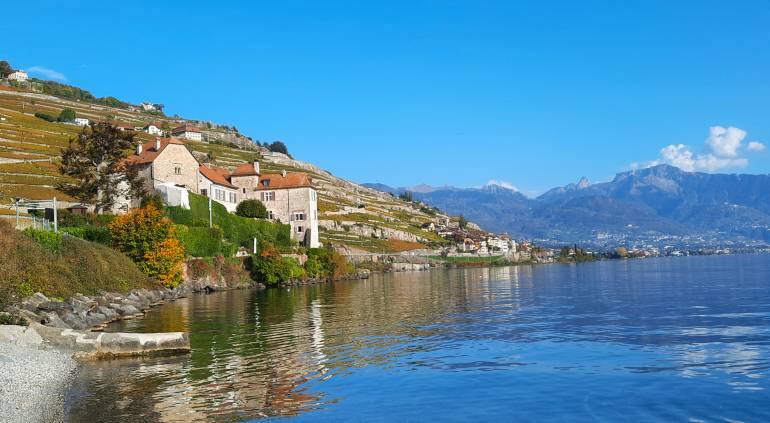 View of Switzerland's Lavaux vineyards from near Lake Geneva. (Photo: Anita Rao Kashi)
View of Switzerland's Lavaux vineyards from near Lake Geneva. (Photo: Anita Rao Kashi)Europe’s heritage-wine tradition Lavaux comes from the eponymous wine region which combines heritage and a lake shore, and is possibly one of the most dramatic and breathtaking of such protected areas. But there are others that are equally magnificent. They have gained their protected status owing to the history of wine-making but they are also stunningly located. Almost uniformly, they are epitomes of centuries-long interaction between people and their environment, which has gone on to develop and optimise local resources in order to produce valued wines that have been crucial for the local economy.
Predictably, a majority of the heritage wine-regions are old world and found largely in Europe, specifically western Europe, though there are a handful spread across other continents.
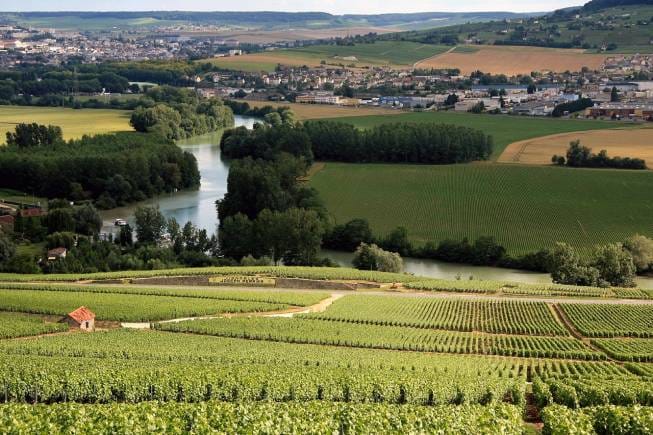 Champagne Vineyards, France. (Photo: Rob and Lisa Meehan via Wikimedia Commons)
Champagne Vineyards, France. (Photo: Rob and Lisa Meehan via Wikimedia Commons)France, with its history of wine-making has the most number of heritage wine sites such as Champagne, Burgundy, Loire Valley and Saint-Émilion, which together produce some of the most recognised varieties. They are thriving cultural landscapes that have evolved and developed over several centuries, through continuation and adaptation of long-standing cultural traditions.
 Croatia’s Stari Grand Plain vineyards. (Photo: Getty Images)
Croatia’s Stari Grand Plain vineyards. (Photo: Getty Images)But echoes of this can be found in Austria’s Wachau, Germany’s Middle Rhine, Italy’s Piedmont and Pantelleria and Portugal’s Azores and Alto Douro to name a few. The scenery and the wines change subtly in central Europe in Hungary’s Tokaj and Croatia’s Stari Grand Plain.
Historical wine Georgian Kvevri, ancient wine vessel. (Photo: Wikimedia Commons)
Georgian Kvevri, ancient wine vessel. (Photo: Wikimedia Commons)But possibly the most fascinating wine-making culture belongs to Georgiain eastern Europe. Legend has it that the country’s wine-making tradition — called Qvevri or Kvevri — goes back 8,000 years. It is still in practice in Georgian villages where different varieties of grapes are grown and takes its name comes from the large egg-shaped earthenware vessel used for making, ageing and storing the wines. And so rather than a region, Unesco has classified it under Intangible Cultural Heritage. Qvevri tradition is also unique in other respects. Once harvested, the grapes are pressed and then the whole mass — grape juice, skin, stalks and pips — are poured into the Qvevri, sealed and buried in the ground for up to six months before being consumed.
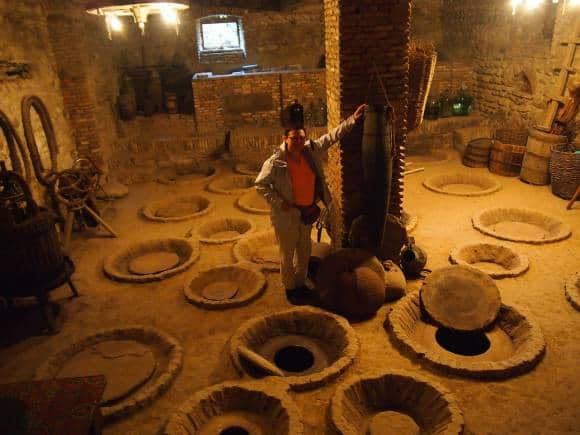 Georgian traditional kvevri jugs buried in a winery in Kakheti. (Photo: Tomasz Przechlewski via Wikimedia Commons)
Georgian traditional kvevri jugs buried in a winery in Kakheti. (Photo: Tomasz Przechlewski via Wikimedia Commons)Knowledge and expertise of the process are passed down in not just families, but also among relatives, friends and neighbours since it is a communal activity. Georgians also believe in starting them young: children are encouraged to look after the vines and compress the grapes, collect clay for the Qvevris and taught the various stages of its production. Clearly, all of it is an integral part of Georgian culture and is celebrated in its oral traditions.
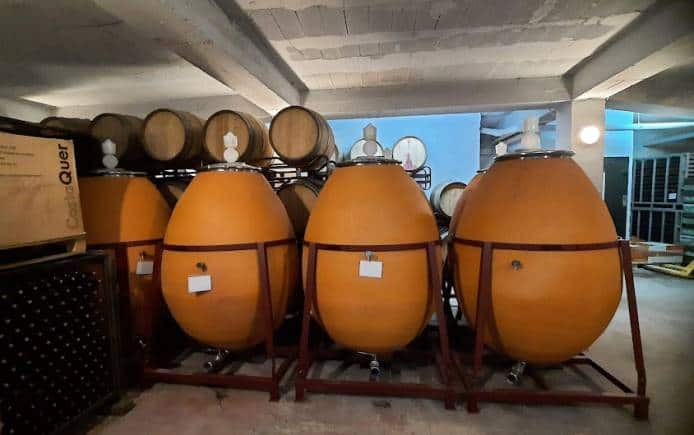 Amphorae, used for wine-making, in Ibiza, Spain. (Photo: Anita Rao Kashi)
Amphorae, used for wine-making, in Ibiza, Spain. (Photo: Anita Rao Kashi)Interestingly, the wine-making tradition in Spain’s Ibizais believed to have originated during the Phoenician times, about 7th century BC. Excavations have yielded old amphorae, similar to the Georgian Qvevri, that were used in wine-making. Wine on the island is protected under the GI tag, and a few wineries have revived the amphora tradition, which result in subtle earthy undertones in the wines that allude to the island’s geography. Clearly, sipping on a glass of wine from any of these regions is all about imbibing history and culture that may as well have been thousands of years in the making.
Discover the latest Business News, Sensex, and Nifty updates. Obtain Personal Finance insights, tax queries, and expert opinions on Moneycontrol or download the Moneycontrol App to stay updated!
Find the best of Al News in one place, specially curated for you every weekend.
Stay on top of the latest tech trends and biggest startup news.